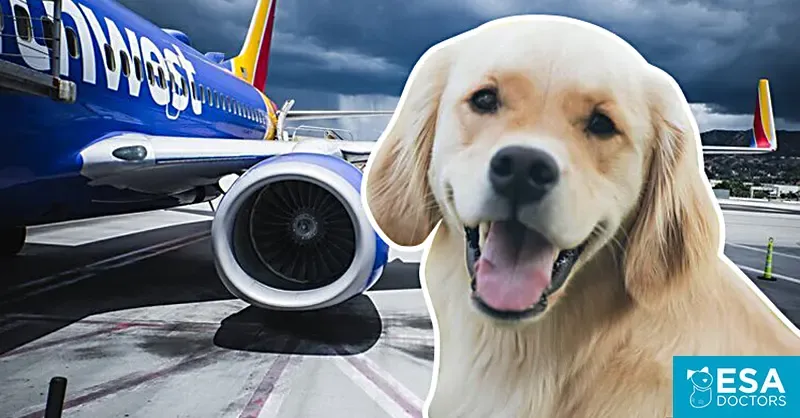A Comprehensive Guide to Flying with an Emotional Support Animal
Flying can cause heightened anxiety and stress for many travelers. If you struggle with flying or have a mental health condition, having an emotional support animal (ESA) by your side on the plane can help provide needed comfort and stability. However, air travel rules for emotional support dogs and other animals are different than regular pets. In this guide, I’ll explain everything you need to know to fly with an ESA on a commercial airline.
Understanding the Difference Between Service Dogs and Emotional Support Animals
- Service dogs, like guide dogs for blind individuals, are specially trained to perform tasks for a person with a disability under the Americans with Disabilities Act (ADA). They have extensive training and have public access rights.
- Emotional support animals provide comfort and companionship to a person with a mental health condition but are not trained to perform specific tasks. ESAs do not have the same public access rights as service animals.
It’s important not to confuse or misrepresent your ESA as a service animal, as that could cause legal issues. While airlines must accommodate ESAs on flights as assistance animals, they have different standards and paperwork requirements than trained service dogs.
Documentation Needed to Fly with an Emotional Support Animal
To bring your ESA into the aircraft cabin rather than the cargo hold, airlines typically require the following documents:
- A letter from your licensed mental health professional (therapist, psychologist, psychiatrist, etc.) on official letterhead. This letter must verify that you have a diagnosed disability and that you need your ESA for emotional support during air travel.
- Recent rabies vaccination certificate for dogs and cats as required by individual states.
- Vaccination records for any other animals as required by the destination.
The letter specifically needs to state that you need your ESA during air travel; a general note about your mental health condition is not sufficient. Give yourself at least one month’s notice to request the letter and scan it as a PDF for flight reservations.
Rules and Regulations for ESAs on Flights
Most major US airlines allow one ESA per passenger in the cabin provided all paperwork and health requirements are met. Here are some key rules:

- The animal must remain at your feet or on your lap and cannot block any aisles or occupy a seat.
- You are responsible for your ESA’s behavior and hygiene. Noise, odors, disruptions, or health/safety issues could lead to being asked to leave with the animal.
- Only dogs, cats, and miniature horses qualify as ESAs. Other animals like pigs, rabbits, etc. are treated as regular pets.
- Some airlines may levy a charge of up to $125 each way for an ESA. Check policies when booking.
- International flights may have additional quarantine or health certificate rules for ESAs to certain destinations.
Airlines reserve the right to deny access if paperwork is incorrect or incomplete or if the animal visibly seems unhealthy. Play it safe and arrive at the airport early with all documentation ready.
Tips for a Stress-Free Flight with Your Emotional Support Animal
From my experience flying with my ESA dog Lulu, here are some tips for a smooth trip:
- Make sure your animal is acclimated to airports, planes, crowds, and loud noises before flying with them as an ESA.
- Use a harness or leash and make sure your dog is well-trained to remain calm on command for take-offs, landings, and turbulence.
- Bring documents and proof of vaccinations directly to the ticket counter rather than checking in online.
- Carry ID tags or a vest labeling your dog as an ESA in case of any questions from airline staff.
- Bring water, food, supplies, waste bags, and poop bags in your carry-on in case of flight delays or if you miss connections.
- Request bulkhead or exit row seating so you have more legroom and your dog isn’t under seat in front of you.
- Maintain good hygiene and don’t let your animal relieve themselves anywhere except designated areas outdoors.
With preparation and responsible ownership, your ESA can provide needed support during stressful air travel. The key is understanding regulations and advocating appropriately for accommodation as an assistance animal.
Overcoming Potential Challenges
While airlines are required to permit ESAs, you may face skepticism from staff or other passengers at times. Maintaining patience and advocating politely but firmly can help in uncomfortable situations. Here are some potential challenges I’ve faced and how I addressed them:
- An agent questioned my ESA paperwork. I calmly explained her role as an ESA for my anxiety and showed my professional letter again.
- A passenger near me complained my dog was too big. I apologized but noted she was under the size limit and airline policy for my diagnosed need.
- My connecting flight was rescheduled due to delays. The gate agent wasn’t familiar with ESAs and initially denied boarding until I cited the regulations.
- My dog barked due to her own anxiety during turbulence. I soothed her with commands and treats to avoid disruption. She calmed down and no further issues arose.
Being polite yet persistent and citing your rights respectfully helps get the needed accommodation while de-escalating any hostility. Few real problems occur with reasonable ESA owners following procedures appropriately. With planning and patience, air travel with your four-legged support need not cause extra anxiety.

Alternative Options If Flying Proves Too Stressful
For some people with severe mental health conditions, the experience of flying can be overwhelmingly traumatic despite an ESA. Here are some alternatives to consider if air travel remains out of reach:
- Travel by personal vehicle or train if distances allow for reduced stress and the ability to stop as needed.
- Discuss medication options with your provider temporarily during trips to reduce anxiety symptoms.
- Consider therapy focused on flights to slowly work on desensitization rather than avoidance whenever possible.
- Look into virtual therapy or guided relaxation sessions during flights for coping assistance.
- As a last resort, see if a medical waiver can allow your ESA and maybe a caregiver to accompany you in the cabin if absolutely necessary for your treatment plan.
There may be no perfect solution. However, with creative problem-solving and compassionate accommodation from airlines when reasonable, many individuals can manage air travel safely with the support of an ESA. Your mental health matters, so advocate determinedly for yourself whenever flying puts your wellness at serious risk.
I hope this guide has helped address your main intentions in understanding flying with an emotional support animal. Please let me know if you need any clarification or have additional questions! Safe travels to you and your furry companion.
Emotional Support Dog Requirements for Flying
| Dog Breed | Animal Training | Owner Documentation |
|---|---|---|
| Mixed or purebred | well-behaved in public | ESA letter from doctor or mental health professional |
| No weight or size limit | Does not relieve itself in cabin | Airline notification at least 48 hours before flight |
| Hypoallergenic dogs allowed | Stays at owner’s feet or on lap | Up-to-date rabies vaccination |
| Breed restrictions vary by airline | Does not bark or cry excessively | Reliable health records |
FAQ
-
Can I bring an emotional support dog on a plane?
Basically, yes – under certain circumstances. An emotional support animal is allowed to accompany its owner in the cabin of a plane. However, airlines have their own rules about emotional support animals. You’ll need to check with the specific airline and provide documentation from your mental health professional.
-
What documentation do I need for an emotional support dog on a plane?
Most airlines need a letter from your doctor or mental health professional stating that you have a diagnosed condition and need the animal for support. The letter should be recent and on official letterhead. Don’t forget too – your dog still needs to behave well and not disturb other passengers. I guess that’s kind of a given, right?

-
Are there size or breed restrictions for emotional support dogs?
While assistance dogs have public access rights, emotional support animals do not. Airlines may have weight and size limits due to space in the cabin. Certain breeds also banned – like pit bulls. It’s best to check airline policies ahead of time to make sure your dog is approved. Air travel isn’t too exciting for dogs either, when you think about it!
-
Do emotional support dogs need any special training?
Not exactly – unlike service animals, emotional support dogs do not need formal training to perform specific tasks. However, they should be well-behaved and able to fit comfortably under the seat. Perhaps more importantly, they need to be comfortable with noise, motion and crowds – you know, like noisy kids!
-
Can an emotional support animal sit on my lap on the plane?
No, emotional support animals are not allowed on a person’s lap in the cabin per Department of Transportation (DOT) rules. They must remain on the floor at the passenger’s feet. I guess an emotional support Great Dane might have an issue there!
-
Do I have to pay a fee for an emotional support dog on a plane?
Generally no – with valid documentation, emotional support animals can fly in the cabin free of charge. You only pay regular fare. Airlines cannot require fees or charge pet deposits for emotional support animals either. Maybe we ought to register ourselves as emotional support humans!
-
Can an emotional support dog be denied boarding?
Despite the documentation, airlines do have the right to deny emotional support animals on the plane if they display aggressive behavior or are too large for the cabin space. They may also be rejected if the handler does not prove they have the pet under control. So be sure to check flight policies and prepare for any outcome.

